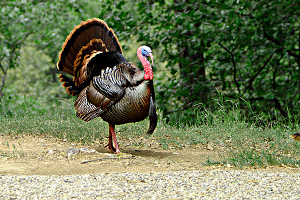 A wild turkey, on display for the local ladies. Photo: Alan Vernon.
A wild turkey, on display for the local ladies. Photo: Alan Vernon.
As Thanksgiving approaches, all thoughts turn to turkeys. Especially when I see a gang of wild ones impeding my progress as I walk to my office in the Berkeley hills. These turkeys are feathered and feisty, strutting on their skinny legs and poking the ground with their sharp beaks.
Wild turkeys, Meleagris gallopavo, are not native to California. They were first introduced to the state for hunting in the 1870s. Subsequent introductions, in the 1920s and 1950s, failed to take—the birds were farm-raised and they didn’t fare well. In the 1970s, California Fish and Game introduced a subspecies called Rio Grande (M. gallopavo intermedia), wild-caught from Texas. This time, the turkeys kept trotting.
Fish and Game estimates that there are now 240,000 wild turkeys in California. Some think of wild turkeys as dinner—you can hunt them, if you have a license. One of my students assures me that they are delicious. However, others think of them as pests. People blame them for digging up gardens, leaving droppings, and scratching cars (especially if a turkey sees his reflection in a shiny car door). To prevent turkeys from damaging your property, California Fish and Game has some recommendations in their Keep Me Wild guide.
